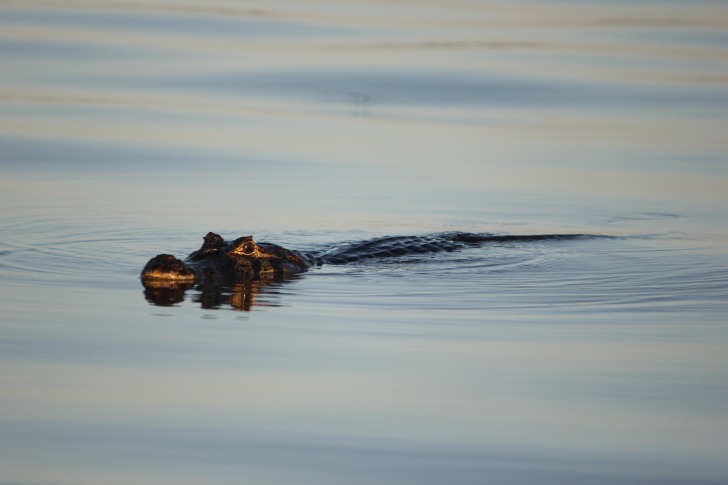Alligators exist in Texas more so than in many other states.
Apparently, the state has adapted this attitude that it’s possible to coexist with them.
I find that hard to believe.
That can’t be true.

Contents
So… Are There Alligators in Texas?
Yes, there definitely are alligators in Texas.
What shocks me is their belief that people can live right along with these creators.
How is that even possible?
Well, just like in other states, such as Florida or Louisiana, Texas locals don’t have much of a choice.
This gives us all something to learn from, especially those who don’t live in states where alligators don’t natively exist.
As far as coexisting, that seems like the ideal.
However, I also did learn that this doesn’t mean you should try to be “buddy-buddy” with an alligator.
In fact, the state of Texas advises not to even (knowingly) swim in alligator-infested waters.
Most of the so-called “coexisting” sound more like avoidance.
However, it also refers to making sure you don’t provoke them by trying to play with them or tease them.
It also calls for not giving them food you’re not authorized to give them.
Another Issue I Never Thought Of
I also learned that you shouldn’t bring your pets (especially dogs) near alligators.
That’s unfortunate.
It may be hard to find a place to swim with your furry companion.
You’d absolutely have to know the water has a zero alligator population if you want to.
Alligator Species in Texas
There are only one alligator species in the United States native to this country, including Texas.
It’s the American Alligator, and it’s known for its thick limbs and slightly rounded body.
They seem to love hanging out in marshes, swamps, and rivers or lakes.
The American Alligator often lives at least 30 years.
Some of them may be alive up to 50 years after they’re born.
They’re cold-blooded creatures, which means their temperature changes with their surroundings.
This alligator species typically likes warmer climates, which explains why you’d find so many in Texas.
They can, however, if they figure out how to survive in a freezing lake.
Alligators in general are often feared, and rightfully so.
I feel like I must respect their spare, or I may get eaten.
I also know, however, that (thankfully) humans aren’t usually the food they’re looking for.
Interesting Alligator Facts in Texas
I didn’t know as much about alligators yesterday as I do today.
I found out more about the American Alligator, which resides in Texas.
- The American Alligator has recovered from near extinction. This happened by way of the Clean Water Act which provided safer places for these large reptiles to inhabit. Hunting and trade control also contribute to not losing this species for good.
- Alligators can propel themselves through the water with their tail. They’re slow-moving creatures overall. However, they can move fast for short distances when they need to. They do at least move more quickly in water than they do on land.
- They’re thought of as a “keystone species.” At least according to the Defender of Wildlife, alligators are thought of as an important (keystone) species. That surprises me because I just imagine them eating up all the other animals from what I just learned.
- Alligators are in 120 Texas Counties. Louisiana reportedly has the most alligators with a population of about two million. Texas has the third largest number of alligators in the U.S., totaling about 400,000-500,000.
- Alligators can’t breathe underwater but spend long times there. Not all sources agree as to how long an American Alligator can stay underwater. Any amount of time is longer than a human’s average of 3-5 minutes. I learned that they may hold their breath for at least 10-20 minutes, sometimes an hour, and sometimes for hours. The extreme record would be about 24 hours.
- Texas has laws against harassing alligators. This doesn’t mean they don’t control where alligators go, and they do deal with aggressive animals. However, they also prohibit “killing, harassing, or possessing alligators.”
Is it Safe to Swim in Texas?
If you follow the state’s guidelines on how to not provoke alligators, you should be fine.
They also say not to feed these animals, and don’t allow children to wander off on a beach alone.
Incidentally, it’s actually illegal to give alligators food.
You especially need to watch out for alligators on the northern Texas coast.
Take extra caution when at Eagle Mountain Lake.
The most recent sighting here was in 2013, by the way.
Additional Swimming Precautions
One of the dangers you would deal with in Texas at a beach is the hot weather.
Wear sunscreen, and stay hydrated with water.
It’s not wise to drink alcohol when out in that heat, even if you are in the water.
Make sure you also pay attention to contamination level reports, just in case the bacteria content is too high for swimming, fishing, etc.
Places You Can Swim in Texas
This list may change, so make sure you pay attention to the latest updates.
Barton Springs Pool, Krause Springs, Devil’s Waterhole, and Blanco State Park are some of the best swimming spots.
You also may find others listed on state park websites.
Local municipalities also may have their own information about the best swimming holes.
Alligators vs. Crocodiles
Texas has just alligators, as far as I know.
If there are any crocodiles in the U.S., it’s most likely at an animal refuge.
All alligators and crocodiles are from the Crocodylia order, but they do have noticeable differences.
Differences in Appearance
It depends on the species to which you’re referring.
However, crocodiles usually have more sensor spots on their body than alligators for detecting and hunting prey.
They also typically have rougher skin and more scales than an alligator.
Crocodiles may have lighter colors than alligators, appearing tan, olive, or another shade.
Alligators typically have a darker “complexion” of dark gray and possibly some dark green skin hues.
Alligators do often have a cream or off-white underside though.
Alligators may not always show off as many teeth, or they may not stick out as much as a crocodile’s.
That’s because their top jawline is larger than the bottom one.
Some of the teeth from an alligator’s bottom jaw fit into spaces within the top jawline.
Crocodiles show off more teeth than an alligator because both their top and bottom jaws are the same size.
You will see some of the teeth from the bottom row of a crocodile stick out of its mouth more than an alligator’s.
Differences in Size
Both crocodiles and alligators are heavy creatures.
Crocodiles are typically heavier, sometimes weighing on average about 500 pounds more than an alligator.
Alligators and crocodiles can weigh a maximum of hundreds or thousands of pounds.
For an adult alligator male, it’s about 500-600 pounds.
For a crocodile, the average is about 1,000 pounds.
Alligators are shorter than crocodiles too.
The adult males often grow 10-15 feet as opposed to the 17-20 maximum that a crocodile will reach in length.
Skeletal/Interior Differences
Alligator legs have some shorter bones in them than crocodiles.
They also don’t have as advanced salt glands as Crocodiles.
Alligator faces are wider, so some of their snout bones are probably wider.
Since the crocodile has a longer snout, the skeletal bones in this part of its body are probably longer.
Being larger than alligators, crocodiles have more muscle mass.
This reportedly makes them the stronger of the two, according to All Animals Guide.
Differences in Behavior
Apparently, crocodiles engage in more aggressive behavior than alligators.
That’s probably a generalization that you’d have to break down by sub-species and classes though.
Considering they have more sensors than alligators, that probably makes them hypervigilant though.
Different Habitat Preferences
Since alligators don’t have highly developed salt glands, they typically prefer living in freshwater.
Crocodiles, on the other hand, can withstand and even thrive in saltier Texas waters.
3 Safety Tips for Swimming in Alligator-Infested Waters
1. Do not ever ignore warning signs.
Never, under any circumstances, swim in an area that has a sign on it that says “DON’T SWIM.”
Even if it doesn’t say that the water has alligators living in it, trust that you’re being told for a good reason not to swim there.
2. Don’t throw fish scraps (or other food) into the water.
That’s part of the “no feeding” alligators rule.
That’s how you avoid stimulating them and having them come near your domain.
Don’t do it.
You could put yourself in danger.
3. Swim spots that fit your skill level.
If you’re just learning how to swim, stay in designated beach or recreation areas.
Don’t wander into unknown or more “adventurous” areas meant for more experienced explorers.

Summary
Texas has the third largest alligator population in the U.S.
Don’t let that scare you from swimming though.
The state teaches “coexistence” and safety.
Texas Safety Overview
READ THE FULL REPORT: Texas Safety Review
Safety Index:
- OVERALL RISK: MEDIUM
- TRANSPORT & TAXIS RISK: LOW
- PICKPOCKETS RISK: LOW
- NATURAL DISASTERS RISK: MEDIUM
- MUGGING RISK: MEDIUM
- TERRORISM RISK: LOW
- SCAMS RISK: LOW
- WOMEN TRAVELERS RISK: LOW
Frequently Asked Questions
When do alligators come out the most?
You’ll usually see them more at dusk and dawn.
It’s best not to swim during these times because they can more easily conceal themselves with just their eyes and nostrils above water.
What do alligators eat?
I found out they could eat just about any other animal.
They don’t seem to have a favorite food.
They eat fish, snakes, birds, land mammals near the water and frogs.
It’s rare that they bite into humans, but that’s probably because humans are told to stay away from them.
Even rarer, alligators have eaten a whole human, but try not to worry too much.
There are ways to protect yourself when swimming, fishing, waterskiing, etc.
Are there any vegetarian alligators?
The closest you’d come to a vegetarian (herbivore) alligator is being fed fishmeal or fish oil when on an alligator farm.
This obviously has a “meat” animal base.
I don’t know if any alligator that’s an herbivore.
Can children swim in Texas?
Yes, they can.
I would never suggest allowing them to swim alone.
No adult should swim alone unless, perhaps, it’s in their own backyard as far as I’m concerned.
When is the best time to swim in Texas?
You should swim during the day before sundown and after sunrise.
That’s the time when alligators will less likely feel hungry.











